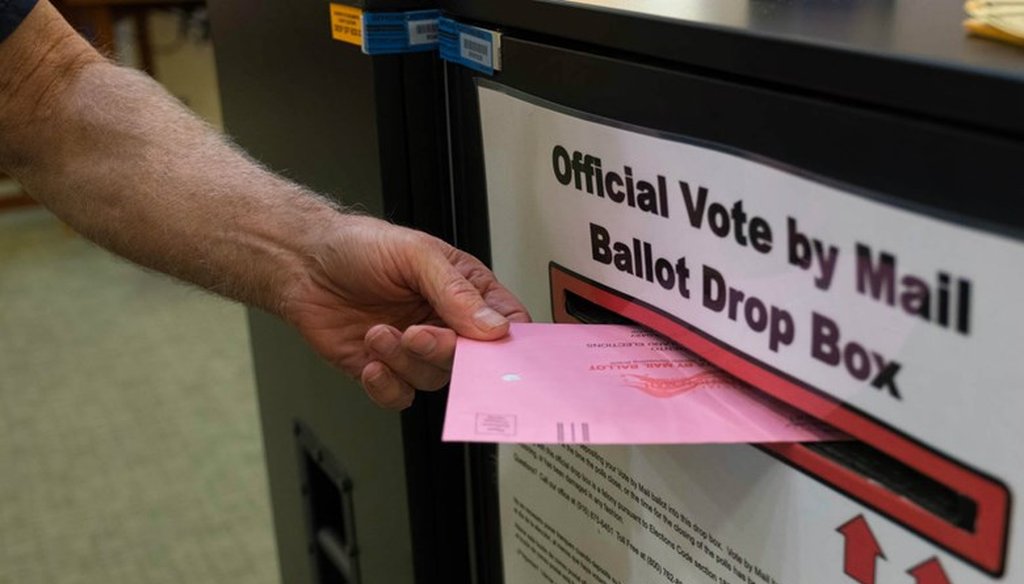Get PolitiFact in your inbox.

A voter returns a vote by mail ballot in California. Andrew Nixon / CapRadio
If Your Time is short
- Vote-by-mail is common in California, where a record 72% of ballots were cast by mail in the March primary.
- Claims by President Trump that vote-by-mail leads to “massive fraud” and hurts Republicans are false, according to recent studies and election experts.
- In California, there are safeguards for voting by mail such as signature matching and unique barcodes on each ballot’s return envelope.
Voting by mail isn’t new in California. It’s been allowed for anyone who’s registered, and for any reason, since 1979, according to the California Voter Foundation.
But with fears that casting a ballot in-person could be risky this fall amid COVID-19, plus President Donald Trump’s misleading claims that mail-in voting "will lead to massive fraud and abuse," there’s a spotlight on this decades-old practice.
California and many other states are getting ready for a surge of absentee voting. In May, Gov. Gavin Newsom ordered all counties to send mail-in ballots to all active registered voters in the state.
GOP groups filed a lawsuit to halt the order, saying it invites theft and cheating and that only the Legislature, not Newsom, has the power to change election laws. State lawmakers have proposed a similar law.
Update: On June 18, Newsom signed AB 860 codifying his executive order to send mail-in ballots to all registered voters in the state. The new law is expected to make the GOP legal challenges moot.
In the Golden State, vote-by-mail is commonplace and getting more so. In the March primary, 72% of ballots cast were by mail, the highest share ever recorded. A majority of voters regularly vote by mail in the state.
Still, as more voters shift to the practice, there are questions about it: How does it work? What safeguards are in place? Does it favor Democrats or Republicans? Is there evidence that vote-by-mail leads to widespread fraud? PolitiFact California spoke with election experts and answered some of these pressing questions.
What do you want to know about vote-by-mail? Send us your request through our Ask PolitiFact California form below. We’ll consider it in future updates to this article.
Does Vote-By-Mail Really Lead To ‘Massive Fraud?’
The answer is no, it hasn't. Several studies have examined the practice and found an extremely low rate of fraud, including a 5-year investigation by the George W. Bush administration that turned up virtually no evidence of any organized effort to skew federal elections.
"Election fraud of all sorts is rare. There is a slightly less rare instance of voter fraud by absentee balloting," said Charles Stewart, a political science professor at the Massachusetts Institute of Technology and co-director of the Caltech/MIT Voting Technology Project, which analyzes election systems. "There are greater temptations and opportunities. Nonetheless, they are rare."
Stewart pointed to one exception: A Miami mayoral election in 1998 "that ended up being full of mail ballot fraud."
More recently, Justin Levitt, a professor at the Loyola Law School in Los Angeles, examined U.S. elections from 2000 to 2014. He found just 31 credible incidents of voter fraud of any kind over that period, during which more than a billion votes were cast.
What Safeguards Are In Place For Vote-By-Mail Ballots?
The biggest protection in California is the signature matching requirement. A voter must sign the outside of their ballot’s envelope. That signature is then matched with the voter’s signature on file from when they registered to vote.
Each vote-by-mail ballot also comes with "an identification envelope that is unique to that voter," said Kim Alexander, president of the California Voter Foundation, which advocates for voters and improving the election process.
"It has a barcode on it for that voter. It has the voter’s address and information on it," said Alexander, explaining that voters must use that envelope to return their ballot. "That’s how the county is going to do two things: Number one, make sure you only vote one time. Number two, make sure they can verify the validity of your ballot without opening it because you have the right to cast a secret ballot."
How Are Mail-In Ballot Signatures Verified?
In all 58 counties, election officials are required to verify signatures by comparing the one on the outside of each ballot envelope with the voter’s signature on file, which is the one provided when a person registers to vote.
Kim Alexander, president of the California Voter Foundation said, however, there’s no consistent method for verifying signatures from county to county.
"They don’t do it in the same way," she said. "Some use software and some use staff people to look at each signature one at a time."
While there are guidelines for the use of software, Alexander said "there are currently not sufficient guidelines statewide" for the overall verification process. Currently, she said, the Secretary of State’s Office is developing new signature verification rules that will be in place for November.
One more note on signature verification: Former California Gov. Jerry Brown signed a law in 2018 that requires election officials to notify voters at least eight days before the certification of the election when they reject a signature and give them a chance to provide a valid one.
Even with that law, some ballots went uncounted.
During the March primary, 27,525 mail-in ballots either didn’t have a signature, or the signature didn’t match the one on record for the voter, the Associated Press reported. Altogether, more than 100,000 mail-in ballots were rejected by election officials, the vast majority because they missed the deadline for the ballot to arrive.
The total number of rejected ballots represents about 1.5% of the nearly 7 million mail-in ballots returned, AP reported.
Research by Alexander’s group has found that an average of nearly two of every 100 mail-in ballots were voided in statewide elections between 2010 and 2018, the AP added. However, over that time, the rate of disqualification has improved, dropping from over 140,000 ballots, or 2.9% in the 2010 general election, to 84,825 ballots, or 1%, in 2018.
Can I Track The Status Of My Vote-By-Mail Ballot?
Yes, voters in many parts of the state can. The Secretary of State’s Office offers the ‘Where’s My Ballot?’ tracking service. Voters can track and receive notifications on each step of the process from when the ballot has been delivered to you to when the completed ballot has been received by your county.
The following counties participate: Amador, El Dorado, Fresno, Glenn, Kern, Los Angeles, Marin, Mariposa, Merced, Monterey, Orange, Placer, Riverside, Sacramento, San Benito, San Joaquin, San Luis Obispo, Santa Clara, Shasta, Sutter, Tehama, Tuolumne, Ventura, Yolo, Yuba.
To sign up, visit: WheresMyBallot.sos.ca.gov
Update: On June 3, Gov. Newsom issued an executive order that requires every county to implement California’s "Where’s My Ballot?" tracking tool. Sam Mahood, a spokesman for the Secretary of State’s Office, said it might take some time to start up in all counties, "but every voter should be able to sign-up for this ballot tracking service ahead of the November General Election."
How Do I Request A Vote-By-Mail Ballot (For This And Future Elections)?
The bill Newsom signed on June 18, AB 860, means the state will send all active registered voters in California a mail-in ballot prior to the November election.
It is designed to ensure voters do not have to go to the polls during a pandemic if they are worried about their health.
Voters can also contact their county elections office to become a permanent vote-by-mail voter. That will ensure they receive a mail-in ballot for all future elections.
In three of California’s sparsely-populated counties, Plumas, Sierra and Alpine, voters automatically receive vote-by-mail ballots. They have no polling places or vote centers. Counties with fewer than 250 voters per precinct can choose this model.
Fifteen others send vote-by-mail ballots to all registered voters under a new model established by the Voter’s Choice Act, which was signed into law in 2016. It allows counties to opt-in to the new system which eliminates many local polling places and replaces them with larger, more centralized vote centers where people can cast a ballot in-person on election day or several days before.
Five counties — Sacramento, Madera, Napa, Nevada, San Mateo — piloted the new system in the 2018 midterm election. Ten more chose to make the switch for the first time this year: Butte, El Dorado, Amador, Calaveras, Tuolumne, Mariposa, Fresno, Santa Clara, Orange, Los Angeles.
Do Mail-In Ballots Include ‘I Voted’ Stickers?
In some counties, vote-by-mail packets do include the popular ‘I Voted’ stickers handed out at polling places and worn by many as a symbol of pride. Sacramento, San Francisco and Los Angeles counties, among others, include them.
What Happens If My Vote-By-Mail Ballot Is Lost Or Stolen?
You can request a second vote-by-mail ballot if your original is lost, stolen or destroyed. Contact your county elections office to be sent another ballot. Counties are able to "cancel out" lost or stolen ballots using a statewide voter registration database called VoteCal, according to Alexander of the California Voter Foundation.
Does Vote-By Mail Favor Republicans Or Democrats?
Trump has repeatedly claimed vote-by-mail hurts Republicans. He even said in an all-caps tweet last week that it would "LEAD TO THE END OF OUR GREAT REPUBLICAN PARTY." Recent studies show that’s not the case.
A Stanford University report published in May found mail-in voting has "no impact" on partisan turnout or vote share. It examined data from 1996 to 2018 from Washington, Oregon, Colorado, Utah and California, states with either universal or widespread mail-in voting. The authors wrote "our paper has a clear takeaway: claims that vote-by-mail fundamentally advantages one party over the other appear overblown."
"Vote by mail favors neither party inherently," added Stewart, the MIT professor. "These days, if you look nationwide there is nary a difference between the usage rate of Democrats and Republicans on average nationwide."
What really matters, Stewart said, is how political campaigns use vote-by-mail. In recent years, "Democratic campaigns have leaned more heavily on early voting and absentee voting than Republicans have. And I think that’s what’s led to this myth that mail voting helps Democrats."
Does Vote-By-Mail Boost Voter Turnout?
Last month, PolitiFact California took a close look at whether vote-by-mail boosts turnout after California Secretary of State Alex Padilla claimed it "helped increase voter turnout rates and not just in blue states like California, but in red states and purple states across the country." Several studies concluded that states with vote-by-mail saw a modest increase in voter turnout. We found, however, the studies do not conclusively prove that introducing vote by mail alone is responsible for boosting turnout.
What Has President Trump Claimed?
For months, President Trump has attacked vote-by-mail. Twitter, for the first time ever, marked one of the president’s tweets with a disclaimer or fact check, after Trump tweeted on May 26:
"There is NO WAY (ZERO!) that Mail-In Ballots will be anything less than substantially fraudulent. Mail boxes will be robbed, ballots will be forged & even illegally printed out & fraudulently signed. The Governor of California is sending Ballots to millions of people, anyone..... ...living in the state, no matter who they are or how they got there, will get one. That will be followed up with professionals telling all of these people, many of whom have never even thought of voting before, how, and for whom, to vote. This will be a Rigged Election. No way!"
PolitiFact California rated that claim Pants On Fire both for the false claim that "anyone" will get a mail-in-ballot in California (the governor has ordered that only registered voters will get one) and for the unsubstantiated comments about voter fraud.
Trump himself requested a mail ballot for Florida’s GOP primary in April and he has voted absentee in previous elections, the Associated Press reported.
Is California Really Going To Send ‘458,000 Mail-In Ballots To Voters Who Have Died Or Moved’?
In July, we published an in-depth examination of this provocative claim by the Election Integrity Project, a citizens watchdog organization. The group’s allegation circulated in conservative news headlines and opinion pieces this spring.
Here’s a summary of our findings: State and county election officials acknowledge that some erroneous ballots will be mailed, given the lag time between a voter moving or dying and the receipt of official notices.
But those who study elections say the claim ignores the detailed voter roll maintenance performed by election officials. Officials use the transmission of death notices, state and national change-of-address information and incarceration records to regularly update the massive voter lists.
Additionally, they use a statewide voter registration database to prevent duplicate registrations.
In the end, we found the group’s claim is a prediction, and its accuracy is difficult to know. What is certain is that election experts reject its suggestion that California’s mail-in ballot system invites fraud and say they’re confident in the safeguards in place.
How Common Is Vote-By-Mail In California And Nationally?
It’s very common and getting more so. The majority of ballots cast in each of the past four general elections and eight primaries in California were by mail, according to the Secretary of State’s Office website.
The practice hasn’t always been so popular. In the 1962 general election, the first for which the Secretary of State lists absentee voting statistics, less than 3% of ballots were sent in via mail. That grew to 6.5% in 1982; 27% by 2002; and 51% by the 2012 general election, the first where a majority of California voters cast mail-in ballots.
Just five states regularly conduct universal vote-by-mail elections: Colorado, Hawaii, Oregon, Utah and Washington. In those states, ballots are automatically sent to all registered voters, who then fill them out and mail them back.
Twelve states allow counties to opt-in to mail-voting or allow it for certain elections, but not others. Voters in another 29 states have the option to vote-by-mail in federal elections, but must request such a ballot.
CapRadio and PolitiFact California will continue answering questions about vote-by-mail and similar topics through the November 2020 election. Email us your questions at [email protected], or contact us on Twitter or Facebook.
Our Sources
Kim Alexander, president, California Voter Foundation, phone interview, May 29, 2020
Rick Hasen, UC Irvine professor of law and political science, phone interview, May 29, 2020
Charles Stewart, Massachusetts Institute of Technology professor of political science, phone interview, May 29, 2020
California Secretary of State, Vote-By-Mail website, accessed June 2020
PolitiFact California, No, California Is Not Sending Mail-In Ballots "To Anyone In The State," As Trump Falsely Claimed, May 26, 2020
PolitiFact California PANTS ON FIRE: Trump’s latest California voter fraud claim as baseless as past allegations, June 24, 2019
Stanford University, Universal Vote-by-Mail Has No Impact on Partisan Turnout or Vote Share, May 6, 2020
Brennan Center for Justice, Bipartisan Support for Expanded Mail Voting for 2020 Elections, April 15, 2020
The Washington Post, Universal vote-by-mail doesn’t benefit any political party, study finds, April 16, 2020
FiveThirtyEight, Few States Are Prepared To Switch To Voting By Mail. That Could Make For A Messy Election., April 27, 2020
PolitiFact, Donald Trump’s dubious claim that 'thousands' are conspiring on mail-ballot fraud, April 9, 2020
The New York Times, Does Vote-by-Mail Favor Democrats? No. It’s a False Argument by Trump., April 10, 2020
The New York Times, In 5-Year Effort, Scant Evidence of Voter Fraud, April 12, 2007
CapRadio, California Republican Party Files Lawsuit Over Gov. Newsom’s Vote-By-Mail Plans, May 26, 2020
NPR, Twitter Points Users To Fact Checks Of Trump Tweets For The First Time, May 26, 2020
















































